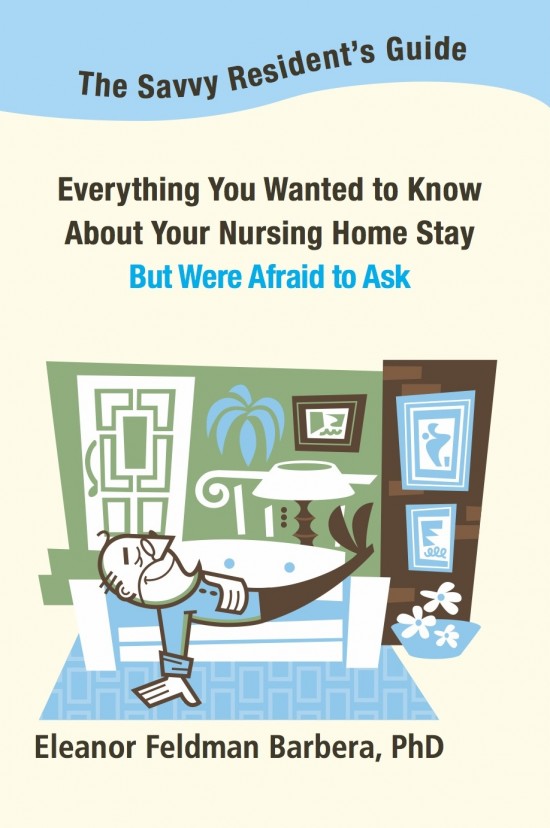Category: McKnight’s Long-Term Care News
Posted by Dr. El - February 15, 2017 - Business Strategies, Common Nursing Home Problems and How Psychologists Can Solve Them, Communication, Customer service, McKnight's Long-Term Care News, Resident education/Support groups, Role of psychologists, Transitions in care

Here’s my latest article on McKnight’s Long-Term Care News:

Long-term care has an image problem. For a variety of reasons, we aren’t associated with good times. There are things we can do to turn this around, though, starting with the perceptions of our residents.
Most people who come to live in a long-term care facility struggle with a sense of failure. This isn’t because of anything that occurred in their lives prior to placement, but because many people view living in a nursing home as a sign of a failed life.
The most common comment I’ve heard from new long-term residents over the years is, “I never thought I’d end up in a place like this.” Some add, “Where did I go wrong?”
There are good reasons for providers to address the inherent sense of failure many residents feel in LTC placement: It can increase customer satisfaction, improve morale among residents and staff, and reduce depression among residents, thereby lessening the need for antidepressants.
The role of the psychologist
Part of my job as a psychologist is to help residents recognize that living in a long-term care facility isn’t a failure. It’s not a reflection of a life poorly lived or necessarily indicative of difficulties in their relationships with their children or other loved ones.
I do this in several ways, depending on the person and the circumstances.
I start by telling residents that I regard it largely as a societal problem. We’ve made advances in healthcare that allow people to live longer with chronic illnesses, but we haven’t yet devoted the resources needed to help people manage successfully at home and to support their caregivers. Long-term care is often the best solution under the circumstances.
Sometimes offering that view is enough to make them feel better about the situation, but other times more is needed. For example, Marie was a new resident who’d worked as an aide in a psychiatric hospital. She was distressed about living in the nursing home and had become irritable and withdrawn. I took her to visit a well-adjusted resident, Linda, who’d been a coworker and a union representative at the same psych hospital. They talked about the old days for 20 minutes and never visited together again, but Marie had a new acceptance for placement — if the nursing home was good enough for Linda the union rep, it was good enough for her too.
As a neutral party, I can provide the perspective that families and facilities can’t, pointing out, for example, how hard family members have worked to keep them out of the facility for as long as they did, how their relationships can reset once someone else is in charge of hands-on caregiving, and the benefits of living in a communal environment with easy access to medical staff and activities.
Organizational component
Aside from referring residents for psychology services, facilities can address this aspect of their image problem in several ways:
For the entire article, visit:

Posted by Dr. El - January 31, 2017 - Business Strategies, Depression/Mental illness/Substance Abuse, For Fun, Inspiration, McKnight's Long-Term Care News, Motivating staff, Stress/Crisis management

Here’s my latest article on McKnight’s Long-Term Care News:

Cold weather. An uncertain world. Rogue shrinks making the rest of us caring, diligent professionals look bad. I don’t know about you, but I need a mood lifter.
I came across an article that suggests that exercise of all kinds, even small movements, can make us feel less depressed. In “Get up and move. It may make you happier,” New York Times health writer Gretchen Reynolds notes that people in a University at Cambridge study “turned out to feel happier when they had been moving in the past quarter-hour than when they had been sitting or lying down, even though most of the time they were not engaged in rigorous activity.”
How can we incorporate more movement into our days across the spectrum of long-term care?
Personally, I purposely forego my car so I can walk to and from the subway and I take the stairs instead of the elevator whenever possible. I encounter surprisingly few coworkers doing the same, so perhaps that can be number one on this list of get-moving ideas:
1. Take the stairs.
2. Use public transportation. Sign up for or offer workers a transit tax exemption if a program, such as TransitChek in New York City, is available in your area.
3. Kill two birds with one stone by walking around the facility on rounds and checking in with staff members and residents.
4. Join or begin a lunchtime walking program. Find a buddy to add fun and accountability.
For the entire article, visit:

Posted by Dr. El - January 19, 2017 - Dementia, Engaging with families, McKnight's Long-Term Care News

Here’s my latest article on McKnight’s Long-Term Care News:

As I’ve mentioned in past columns, delivering high quality care for residents and their families means accepting our role not only as care providers but also as educators throughout the process.
This often involves teaching family members about illnesses so that they can become strong members of the treatment team, rather than bringing sweets to someone with diabetes or inadvertently agitating a resident with dementia.
As anyone who’s visited a doctor knows, however, it’s easy to become overwhelmed and to have the information presented by the medical professional blur so that it sounds like a Charlie Brown cartoon teacher declaring, “Wa wa wa wa, wa wa wa wa wa wa.”
I recently learned of a promising program to teach families — particularly Hispanic families — about dementia in a manner that makes the information easier to hear: an audio-visual novella called “Forgotten Memories” (“Recuerdos Olvidados”), which is available on YouTube in English and in Spanish.
The novella, by the University of Southern California School of Pharmacy in association with USC Good Neighbors Campaign, USC Dornsife College of Letters, Arts and Sciences, and USC Alzheimer Disease Research Center, tells the story of a man whose forgetfulness begins to impact his daily life and to affect three generations of his family.
For the entire article, visit:

Posted by Dr. El - January 3, 2017 - Business Strategies, McKnight's Long-Term Care News

Here’s my latest article on McKnight’s Long-Term Care News:

I don’t make New Year’s resolutions.
I do, however, have a list of goals I’d like to accomplish this year, including editing the first draft of my novel, finishing the illustrated book I started, scheduling more speaking engagements, and writing more articles. Plus personal goals such as meditating more often and taking more vacation time.
Perhaps you, like me, have a scroll’s worth of plans for 2017. Maybe you hope to improve hiring practices, boost the census, enhance teamwork and communication, increase insurance reimbursement and begin innovative new programming that generates more income.
Perhaps you, like me, recognize the impossibility of completing all of this in one year.
Rather than resolve to do more than I can possibly accomplish, I prefer to view the beginning of the year as a time to examine the course I’ve been on and to make corrections as needed.
The American Psychological Association (APA) makes several recommendations for individuals around setting goals for the year. I’ve applied their counsel to long-term care organizations below:
1. Start small: The APA suggests making adjustments “that you think you can keep,” rather than sweeping changes. This reminds me of the recommendation offered last year by David Gifford, MD, MPH, Senior Vice President of Quality and Regulatory Affairs of the American Health Care Association to run pilot studies when looking to alter systems within an organization, using the model of “one staff member, one resident, one day.” This creates the opportunity to problem-solve along the way, before substantial time and financial resources have been committed. This template could apply to a multitude of situations, from programming to hiring practices to new ways of monitoring insurance reimbursement.
2. Change one behavior at a time: Unhealthy behaviors in individuals and organizations develop over time and it takes time to replace them with healthy behaviors. The APA suggests choosing a focus of change to prevent becoming overwhelmed by attempting too much at once. For example, a nursing director who’s typically inundated with personnel complaints might create open office hours that allow him or her to be available while reserving time for other important activities. An administrator who wants to address staffing issues could start with half an hour each morning to walk through the facility and talk to employees. A few months later, another action could be taken based on what’s been learned.
For the entire article, visit:

Posted by Dr. El - December 22, 2016 - Business Strategies, Communication, Customer service, Engaging with families, McKnight's Long-Term Care News, Tips for gifts, visits

Here’s my latest article on McKnight’s Long-Term Care News:

In his Dec. 6 McKnight’s Senior Living column, Editorial Director John O’Connor reported on a senior living center in Jiangsu province in China that offers cash rewards to people who visit their loved ones. Ten visits in a two-month period led to the equivalent of about $10; thirty visits brought about $29.
The result? The number of residents receiving regular visitors jumped from 10% to about half, no doubt making a huge impact on the lives of the residents and on the culture of the facility.
While this “positive reinforcement” obviously can be very valuable — and I agree with O’Connor’s alternatives to cash such as gift cards or entry into a raffle for a local restaurant — there’s a lot we can do to make family visits inherently more rewarding.
When long-term care providers accept the role of teachers, we can add great value to our services and enhance the experiences of the families who come to us for assistance.
The reality is that many relatives have no idea how to best engage with their loved one in long-term care.
Visitors often ask questions in ways that lead to frustration or embarrassment rather than the heart-to-heart they’re seeking. A television blaring in the background can make it difficult to maintain a conversation. Family members trying to do the right thing by visiting are met with disappointment and frustration rather than joyful connection. When visits don’t go as hoped, it can create what feels like punishment instead of reward.
Take a moment to listen to the comments of the visitors on the way out the door this holiday season. Look at their expressions. Do people seem satisfied with their visits or can more be done to create a pleasant experience? Astute administrators and nursing directors might overhear remarks such as, “Dad didn’t hear a thing I was saying,” or, “She couldn’t remember anything. I didn’t know what to say to her.”
Family visits can be vastly improved with some basic tools and education. Here are some ideas for this year and next:
For the entire article, visit:

Posted by Dr. El - December 7, 2016 - Books/media of note, Bullying/Senior bullying, Business Strategies, Common Nursing Home Problems and How Psychologists Can Solve Them, Customer service, Dementia, Engaging with families, McKnight's Long-Term Care News

The Savvy Resident’s Guide can help set reasonable expectations for your new residents and families, leading them to view their stays in a more favorable light. To see how, download a FREE Kindle version between December 7-9th and take advantage of Holidays Savings of 20% off bulk orders of 25 or more copies through Friday, December 23rd. Use the code MCKNIGHTS at checkout.
It’s like giving people 24/7 access to an experienced nursing home shrink who tells it like it is with gentle humor and answers every question before it’s asked. Put a copy in every rehab room and watch your customer satisfaction reviews improve!
For more great resources, read my latest article on McKnight’s Long-Term Care News:

Over the past year, I’ve been involved with several exciting long-term care-related projects that I can now tell you about. In the spirit of the season, I wanted to spread some good cheer with them*, and also offer a gift.
The first is a book entitled “Bullying Among Older Adults: How to Recognize and Address an Unseen Epidemic” by Robin P. Bonifas, to which I had the honor of contributing a chapter. This volume addresses the effects of bullying among seniors and outlines actions which facilities and communities can take to address the problem. It provides step-by-step assessment strategies and anti-bullying interventions that will increase staff awareness and improve day-to-day interactions.
In another publication, fellow geropsychologists Kelly O’Shea Carney and Margaret P. Norris have put their years of experience to paper in “Transforming Long-Term Care: Expanded Roles for Mental Health Professionals.” As I state in my review of their work, “The book will … appeal to long-term care policy strategists and facility managers looking for ways to reduce costs while improving care quality and staff turnover.” The book digs deeper into the Eldercare Method (which I earlier discussed here) and outlines ways in which long-term care can make better use of its consulting psychologists.
.
.
.
And finally, I’d like to offer the opportunity to download — through this Friday — a free Kindle version of my book, “The Savvy Resident’s Guide: Everything You Wanted to Know About Your Nursing Home Stay But Were Afraid to Ask.” This large-print guidebook provides essential facility-friendly information in an entertaining format for residents and family members regarding how to make the most of their time in a nursing home. (If you like it as much as I think you will, order here by Dec. 23 for a 20% discount for purchases of 25 or more. Use the code MCKNIGHTS upon checkout.)
*Full disclosure: I do not benefit financially from mentioning the resources of my colleagues or from any purchases of their products.
For the entire article, visit:

Posted by Dr. El - November 22, 2016 - Communication, McKnight's Long-Term Care News, Personal Reflections, Resident education/Support groups, Stress/Crisis management

Here’s my latest article on McKnight’s Long-Term Care News:

The 2016 presidential election has revealed a deep rift in our country, and quite possibly in our long-term care facilities as well.
While some employees and residents are pleased about the election results, it’s likely that others in your community are considerable less so.
An informal survey of my fellow geropsychologists revealed the following situations occurring in their nursing homes:
• Staff arguments regarding politics.
• Anger in residents, some of whom are misdirecting their anger.
• Residents and staff members who are dismayed, distraught or depressed regarding the election results and the direction of the country.
• Residents reporting that staff members told them they voted for Trump but asked them to keep this secret because they don’t want their Clinton-supporting coworkers to know.
• Staff who openly voted for and are discussing their Trump votes with clients as a point of pride, without recognizing the impact on their disabled clients after Trump’s mocking of a disabled person.
• Transgender residents concerned they are going to be “outed” and will be refused the medication they’ve been taking for years to maintain their health.
• Aides and other staff (housekeeping, kitchen workers) crying in staff lounges out of fear that some of their family members might be deported and that they, too, would have to return to their country of origin because they wouldn’t be able to afford to stay here on their own. As they shared their fears with their respective residents, the possibility that their beloved aide might leave them added to the anxiety the resident might have already felt about the election results.
• Staff concerned about their jobs and the future of healthcare; residents fearful they will no longer be eligible for Medicaid if the laws change.
Certainly not every facility is experiencing such reactions — a psychologist working in a VA home indicated that the veterans seemed generally positive about the prospect of President Trump.
Another psychologist reported that a Romanian Holocaust survivor was pleased with Trump’s win because he’d feared the country was moving toward a socialist model he’d unhappily lived through previously.
With our diverse population of residents and staff members, however, it’s likely there are at least some people in our communities who are experiencing distress and would benefit from reassurance and support from those in charge.
Here are 6 ways to accomplish this:
1. If you haven’t already done so, send a memo requesting that staff members refrain from discussing politics, especially in front of residents.
2. Reiterate to staff members the corporate policies regarding discrimination and express a commitment to a fair and bias-free environment.
For the entire article, visit:

Posted by Dr. El - November 10, 2016 - Communication, Depression/Mental illness/Substance Abuse, McKnight's Long-Term Care News, Resident care, Role of psychologists, Stress/Crisis management

Here’s my latest article on McKnight’s Long-Term Care News:

In preparing for a webinar on suicide prevention, I came across startling statistics about suicide rates among older adults. Despite the concern we often hear about teen suicide, the rate for elders is even higher.
While older adults make up 12% of the U.S. population, they account for 18% of all suicide deaths. In 2014, the highest suicide rate in the U.S. population (19.3 per 100,000 people) was among people 85 years or older.
In addition, elder suicide may be under reported by 40% or more. Not counted are “silent suicides,” like deaths from overdoses, self-starvation or dehydration, and “accidents.”
Training staff to assess suicide
Given its prevalence, it’s important for long-term care staff members to know how to recognize and address suicidal thinking and behaviors.
As a psychologist who’s been assessing suicidality since my teen years as a peer counselor in college, I feel comfortable with the process. Most facility staff members, however, haven’t had extensive training and are understandably anxious about an issue that’s likely to be out of their area of expertise. This can lead to over-caution, such as unnecessary one-to-one observation, or to missing signs of distress.
Staff training programs should educate team members about factors increasing the likelihood of depression and thoughts of suicide. Many of these influences are prevalent in our elderly population, such as physical illness, pain, functional impairment, losses and social disconnectedness.
Make use of consulting psychologists by referring residents for evaluation after losses and a decline in condition such as a downgrade in diet from chopped to pureed food, a limb loss, a move from a wheelchair to a reclining chair or a death in the family.
Team communication and support
Virtually all workers know it’s necessary to inform the charge nurse and other personnel about direct statements such as “I want to kill myself,” but staff members should be trained to look for other warning signs of potential suicide, which include changes in grooming, loss of interest in previously appealing activities, giving away possessions and making statements like, “I won’t be needing any more appointments.”
For the entire article, visit:

Posted by Dr. El - October 27, 2016 - Business Strategies, For Fun, Inspiration, McKnight's Long-Term Care News, Motivating staff

Here’s my latest article on McKnight’s Long-Term Care News:

After reading a recent New York Times Opinion piece about the uses of lotteries to solve social problems, I began contemplating their potential application to long-term care.
According to “For Better Citizenship, Scratch and Win,” lotteries have been used to encourage voting, reduce speeding and even to attend to health needs such as getting tuberculosis screening, practicing safer sex and keeping medical appointments.
In one example, to combat tax evasion on small purchases, the Chinese government encouraged people to obtain receipts by turning them into scratch-off lottery tickets — leading to tax revenue amounting to 30 times the cost of the lottery prizes!
The theory is that lotteries are appealing because people want rewards and they enjoy playing games. As the CEO of a company that designs games for businesses put it, “They could… have everyone get an incentive for $15. But they’d get better results for the same average price by having variability — some get $10, some get $100.”
An element of fun might be a welcome addition to what’s typically the very serious business of long-term care. Presenting awards with humor and the thrill of winning a game could help offset the strain of coping with the ongoing losses inherent in direct care.
In addition, offering a lottery might appeal to a larger pool of workers. I often hear about the challenges of inducing less-engaged employees to improve their performance. Typical rewards, such as “employee of the month” programs, tend to honor those who are already committed and doing their best. Perhaps a lottery would engage disenfranchised workers in a way that other incentives have not.
Here are some playful ideas for applying lottery-style encouragement to long-term care:
1. The Show Up on Time Game: In the SHOUT Game, all employees who arrive to work on a timely basis for the week get entered into a lottery, which takes place at the end of the month. Each employee therefore has the opportunity to enter four or five times, depending on their timeliness and the number of weeks in the month. Winners of the drawing would get various prizes, which could be monetary, gift certificates to local enterprises or perks such as a good parking spot.
For the entire article, visit:

Posted by Dr. El - October 11, 2016 - Business Strategies, Communication, Customer service, McKnight's Long-Term Care News, Resident/Family councils

Here’s my latest article on McKnight’s Long-Term Care News:

When it comes to resident councils, it’s often thought that an active resident council might seem good in theory, but that it’s offset by the amount of staff time required to devote to the process and concern that something written in the meeting notes will trigger an inquiry by state surveyors.
This line of reasoning, while raising legitimate concerns that need to be managed, gives short shrift to the benefits of a strong resident council.
Resident councils can be awesome for your facility and here’s why:
1. Residents tell it like it is: You know those things your staff members see but don’t mention because they don’t want to rock the boat? Residents are far more likely to speak up than the average staff member because they’re not worried about losing their jobs.
Some of them are like my Aunt Bevy, who used to tell me, “Eleanor, I can say what I want. I’m an old lady.” Tap into this important source of info and find out what’s really working, and not, in your facility.
Residents will tell you what you need to know to make your facility shine enough to attract more residents.
2. Free labor: I hate to be so crass about it but let’s face it: While everyone else is running around your organization like lunatics because they’re short-staffed, your residents are sitting around hoping for something interesting to do. We have a pool of diverse, experienced, motivated and often bored individuals yearning to be put to good use.
Sure, they’ll need some help to overcome their physical limitations, but working together they can effectively address many seemingly intractable problems. Maybe they could raise money to contribute toward an herb garden for the patio or start a welcoming committee to reduce the isolation of new residents. Ask them what they want to do – it might be exactly what’s needed to revitalize demoralized staff members and energize your institution.
For the entire article, visit:





















